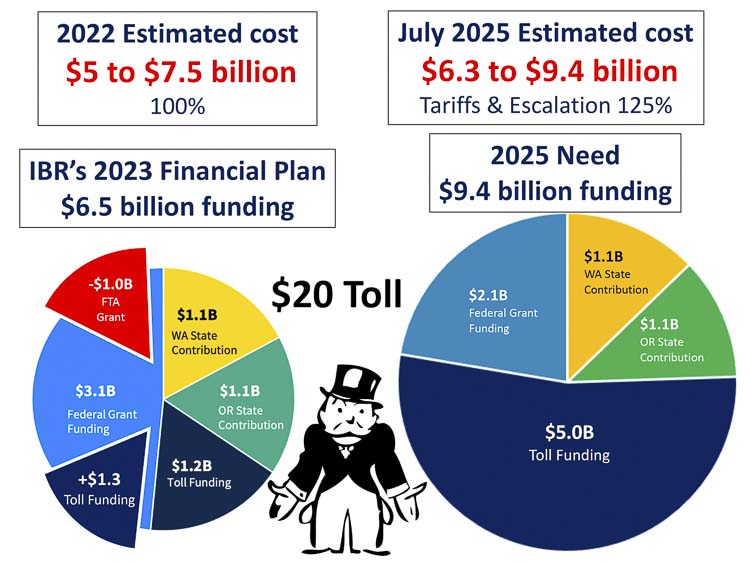
Bob Ortblad offers further analysis of I-5 Bridge replacement costs
Editor’s note: Opinions expressed in this letter to the editor are those of the author alone and do not reflect the editorial position of ClarkCountyToday.com
Washington Representative John Ley’s recent article, “Can $10 tolls be coming to the Interstate Bridge?” significantly underestimates potential toll costs, which could be closer to $20.

The Interstate Bridge Replacement Program’s (IBR) “2023 Financial Plan” appears overly optimistic, starting with a $1 billion shortfall: $6.5 billion in funds minus an estimated $7.5 billion in costs equals a $1.0 billion deficit. Furthermore, a $1 billion grant from the Federal Transit Administration faces a low chance of success due to low ridership numbers, impractical elevated stations, and park-and-ride garages situated near the freeway, which promote additional vehicle miles traveled (VMT) and contribute to urban sprawl. To compensate for the expected shortfall from the loss of a Federal Transit Administration grant, the Washington Legislature is proposing $2.5 billion in toll bonds, which is a $1.3 billion increase over the IBR’s original plan.
The IBR’s last cost estimate was issued in 2022, with a new estimate slated for release in July 2025, after the sessions of both Washington and Oregon legislatures conclude. Recent tariffs and cost escalations are likely to raise the total by a conservative 25%, pushing the estimated cost to around $9.4 billion. Both Washington and Oregon are facing transportation budget crises, with little hope for additional federal funding. Thus, the only remaining source of funds appears to be $5 billion in tolls, potentially driving tolls up to an exorbitant $20 per crossing.
The IBR needs a more cost-effective design. It should cancel plans to widen five miles of freeway and reconstruct five interchanges, two massive bridge approaches, and an oversized bridge. A more viable solution would involve preserving the current bridges, which have six lanes, and constructing an immersed tunnel with four or six additional lanes. This alternative would be more cost-effective and offer many environmental and safety benefits.
Bob Ortblad MSCE, MBA
Seattle
Also read:
- 6-cent gas tax hike central to new transportation deal in WA LegislatureA proposed 6-cent gas tax hike is central to a transportation funding deal under negotiation in the Washington Legislature, aimed at raising $3.2 billion over six years.
- Letter: C-TRAN Board improper meeting conductCamas resident Rick Vermeers criticizes the C-TRAN Board for misusing parliamentary procedure during a controversial vote on light rail.
- Opinion: TriMet’s ‘fiscal cliff’ a caution for Clark County taxpayersRep. John Ley warns that Portland’s financially troubled TriMet transit system could pose major risks to Clark County taxpayers as the I-5 Bridge replacement moves forward.
- Travel Advisory: Expect daytime delays on northbound I-5 near Woodland for guardrail repairs, April 18WSDOT will close the left lane of northbound I-5 near Woodland on Friday, April 18, to repair guardrail and improve driver safety.
- Belkot speaks before C-TRAN board; directors pause vote on light rail funding language until JulyMichelle Belkot spoke at Tuesday’s C-TRAN board meeting, calling her removal from the board unlawful; directors postponed a vote on light rail funding language until July amid legal challenges.









